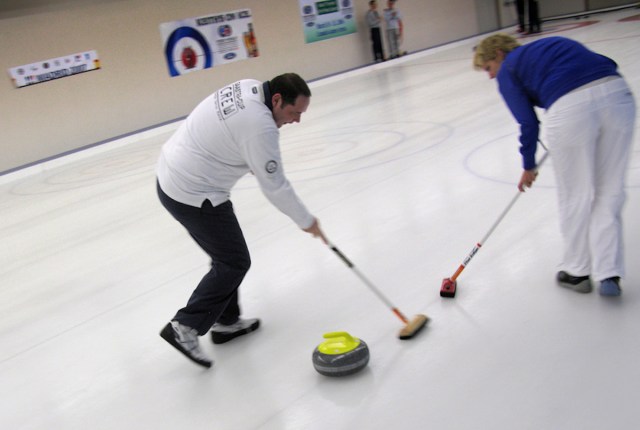Learn Why Curling Has So Much Sweeping, Because Science Is the Best Part of Sports
Also known as "Professional Ice Cleaning." (Citation needed.)
The universe has played a cruel trick on athletes by deciding that all of their sports need science to hide just under the surface and make them work, so the Olympics are a great excuse to learn some science. Today, I’ll tell you the science behind icy shuffle board—I mean, curling—so you can learn why it involves so much sweeping.
Yeah, you know, the sport where competitors slide big stones down an icy lane to try to get them into a target zone, and the rest of the team follows along and looks like they’re trying to clean up after it in reverse? Right, that one. So what’s up with all of that sweeping, anyway? All in good time, grasshopper. First, it’s important to understand the nature of curling ice.
Unlike most ice-based sports, curling ice is deliberately made bumpy instead of smooth by spraying water droplets onto the surface of the ice and letting them freeze. These bumps actually allow the curling stone, which is made from special granite that won’t break on impacting other stones, to travel faster, because only the very tops of the bumps come into contact with the stone, which leads to less friction.
This also causes the stone to spin, or curl, which is where curling gets its name. With the uneven friction of the bumps on the ice, one side of the stone slides faster than the other, and that causes it to spin and slightly curve its trajectory towards the side that’s traveling slower, which is one of the reasons the sweepers sweep.
Quickly polishing the ice before the stone passes over it reduces friction by polishing the top of the ice and warming it, which increases friction’s melting effect. That makes the ice more slippery and reduces the trajectory-curving effect of the stone’s “curl,” which is an important asset in a game of accuracy. The added slidey-ness (technical term), also makes the stone go farther, which allows the thrower to play a little more fast and loose with how hard the stone is thrown.
According to The Curling School, the distance window for the thrower is actually pretty wide, and the sweepers are mostly responsible for where the stone ends up:
The amount of force necessary to propel a rock forward is known as “weight”. Good sweepers can add an additional 8 – 12 feet to a rock’s distance. This is important to know because, as you are throwing the rock, your throwing weight needs only to fall inside this 8-12 foot “weight window”. This provides a fairly comfortable margin of error for the thrower.
Example: A rock thrown 8 feet short of the house without sweeping can easily be swept into the house by good sweepers. As a thrower, your responsibility was to hit the window and not the actual finished shot. This is what makes sweeping such a critical part of the game.
Now, armed with knowledge, you can tell your more sports-minded friends all about the science behind curling and annoy the Hell out of them—even more than you already do by watching curling, which you should do, because it’s great.
(via The Curling School, image via Genlab Frank)
- Hey, there’s science in figure skating, too
- AsapSCIENCE explains how music may improve athletic performance
- And they’ve got a whole Olympic science video series, too
Have a tip we should know? tips@themarysue.com
